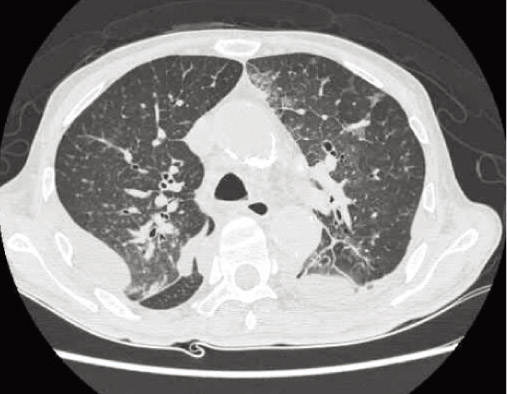Infect Chemother.
2010 Apr;42(2):103-106.
A Case of Oseltamivir-Resistant Pandemic Influenza (H1N1 2009)
- Affiliations
-
- 1Department of Internal Medicine, Catholic University of Daegu, School of Medicine, Daegu, Korea. heeya0035@cu.ac.kr
- 2Division of Influenza Virus, Center for Infectious Diseases, National Institute of Health, Centers for Disease Control and Prevention, Seoul, Korea.
Abstract
- In April 2009, the first swine origin pandemic influenza (H1N1 2009) infection was reported in Mexico and United states and has since spread rapidly worldwide. Finally on June 11, 2009, WHO officially declared the first pandemic of the 21st century. Until March 2010, more than 213 countries reported laboratory confirmed cases of pandemic influenza H1N1 2009, including at least 16,931 deaths. The drug of choice for treatment and prophylaxis of pandemic (H1N1) 2009 influenza are the neuraminidase inhibitor (oseltamivir and Zanamivir). However, increased use of these drugs lead to the emergence of oseltamivir-resistant strains. We report a case of oseltamivir-resistant pandemic influenza (H1N1 2009) virus infection in a patient who were initially started with oseltamivir for laboratory-confirmed influenza. Patient's symptoms worsened despite the use of high-dose oral oseltamivir, and antiviral susceptibility test showed oseltamivir resistance (H275Y mutation). The patient resolved after treatment with zanamivir.
Keyword
MeSH Terms
Figure
Reference
-
1. World Health organization(WHO). World now at the start of 2009 influenza pandemic. 2009. 06. 11. Accessed 30 Mar 2010. Available at: http://www.who.int/mediacentre/news/statements/2009/h1n1_pandemic_phase6_20090611/en/index.html.2. World Health organization(WHO). Pandemic(H1N1) 2009. Disease outbreak news - situation update 93. Accessed 5 April 2010. Available at: http://www.who.int/csr/don/2010_03_26/en/index.html.3. WHO. Pandemic (H1N1) 2009 briefing note 1: Viruses resistant to oseltamivir (Tamiflu) identified. Wkly Epidemiol Rec. 2009. 84:299–399.4. World Health organization(WHO). Pandemic(H1N1) 2009. antiviral drug resistance. Accessed 29 Mar 2010. Available at: http://www.who.int/csr/disease/swineflu/frequently_asked_questions/antivirals/resistance/en/.5. KCDC. Epidemiological study of five patients with oseltamivirresistant Influenza A(H1N1) in Korea. Public health weekly report. Accessed 10 Mar 2010. Avarilable at: http://www.cdc.go.kr/kcdchome/jsp/home/information/had/INFOHAD0001Detail.jsp?menuid=100053&contentid=10810&appid=kcdchome&content=/contents/information/had/b/10810_view.html&pageNum=2&menutitleurl=null&q_had01=B&q_had02=2010&sub=4&q_had01=B&q_had02=2010&pageNo=5.6. Centers for Disease Control and Prevention (CDC). Update: drug susceptibility of swine-origin influenza A (H1N1) viruses, April 2009. MMWR Morb Mortal Wkly. 2009. 58:433–435.7. Centers for Disease Control and Prevention (CDC). A weekly influenza surveillance report: 2009-2010 influenza season week 14 ending April 10, 2010. Accessed 18 April 2010. Available at: http://www.cdc.gov/flu/weekly/index.htm.8. Moscona A. Global transmission of oseltamivir-resistant influenza. N Engl J Med. 2009. 360:953–956.
Article9. Novel Swine-Origin Influenza A (H1N1) Virus Investigation Team. Dawood FS, Jain S, Finelli L, Shaw MW, Lindstrom S, Garten RJ, Gubareva LV, Xu X, Bridges CB, Uyeki TM. Emergence of a novel swine-origin influenza A (H1N1) virus in humans. N Engl J Med. 2009. 360:2605–2615.
Article10. Choi WY, Kim S, Lee N, Kwon M, Yang I, Kim MJ, Cheong SG, Kwon D, Lee JY, Oh HB, Kang C. Amantadine-resistant influenza A viruses isolated in South Korea from 2003 to 2009. Antiviral Res. 2009. 84:199–202.
Article
- Full Text Links
- Actions
-
Cited
- CITED
-
- Close
- Share
- Similar articles
-
- The Diagnosis and Treatment of Influenza
- A Case of Oseltamivir-Resistant Pandemic Influenza (H1N1 2009) in a Patient with Acute Myeloid Leukemia
- The Emergence of Oseltamivir-Resistant Seasonal Influenza A (H1N1) Virus in Korea During the 2008-2009 Season
- Diagnosis and Management of Novel Influenza A (H1N1)
- Three Reinfection Cases of the Pandemic Influenza (H1N1 2009)




